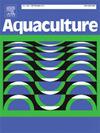High lipolytic capacity improves cold tolerance in red swamp crayfish (Procambarus clarkii)
IF 3.9
1区 农林科学
Q1 FISHERIES
引用次数: 0
Abstract
Temperature is one of the most prevalent environmental factors that affects the growth and development of organisms. The survival of aquatic animals is closely related to the changes in temperature, low temperature could cause physiological damage even death. In this study, we revealed the regulatory mechanisms of low-temperature stimulation from the transcriptomics in the hepatopancreas of the red swamp crayfish, Procambarus clarkii. Transcriptome sequencing revealed that lipid metabolism pathways were significantly enriched at low temperature. Crayfish improved their cold tolerance by increasing expression levels of thermogenic gene prdm16 and uncoupling protein genes ucp4 and ucp5. Furthermore, lipid and triglyceride content increased significantly in cold-sensitive crayfish, which in turn increased the expression levels of proinflammatory factors (cox2 and tgfβr) and the amount of hepatopancreas bacteria. In addition, low-temperature stimulation could cause more severe damage to cold-sensitive crayfish spermatophores, accompanied by downregulated of spermatozoa viability-related genes such as alp and ldh. Estradiol 17β-dehydrogenase 8-like (17βde8) may contain a critical SNP site at exon 544, the bases of this site were “G” in cold-tolerant crayfish and “A” in cold-sensitive crayfish. Above all, our results reveal that lipid metabolism is the main factor affecting cold tolerance in crayfish and reveal the key loci for cold tolerance, providing a reference for cold tolerance breeding.
高脂肪分解能力提高了红色沼泽小龙虾(Procambarus clarkii)的耐寒能力
温度是影响生物生长和发育的最普遍的环境因素之一。水生动物的生存与温度的变化息息相关,低温会造成水生动物的生理损伤甚至死亡。本研究从红色沼泽螯虾肝胰腺的转录组学揭示了低温刺激的调控机制。转录组测序发现,脂质代谢通路在低温条件下显著富集。小龙虾通过提高产热基因prdm16以及解偶联蛋白基因ucp4和ucp5的表达水平来提高耐寒能力。此外,对低温敏感的小龙虾体内的脂质和甘油三酯含量显著增加,这反过来又增加了促炎因子(cox2 和 tgfβr)的表达水平和肝胰腺细菌的数量。此外,低温刺激会对冷敏感的小龙虾精原细胞造成更严重的损伤,并导致精子活力相关基因(如 alp 和 ldh)下调。雌二醇17β-脱氢酶8-like(17βde8)外显子544处可能含有一个关键的SNP位点,耐寒小龙虾的该位点碱基为 "G",而对冷敏感小龙虾的该位点碱基为 "A"。总之,我们的研究结果揭示了脂质代谢是影响小龙虾耐寒性的主要因素,并揭示了耐寒性的关键位点,为耐寒性育种提供了参考。
本文章由计算机程序翻译,如有差异,请以英文原文为准。
求助全文
约1分钟内获得全文
求助全文
来源期刊

Aquaculture
农林科学-海洋与淡水生物学
CiteScore
8.60
自引率
17.80%
发文量
1246
审稿时长
56 days
期刊介绍:
Aquaculture is an international journal for the exploration, improvement and management of all freshwater and marine food resources. It publishes novel and innovative research of world-wide interest on farming of aquatic organisms, which includes finfish, mollusks, crustaceans and aquatic plants for human consumption. Research on ornamentals is not a focus of the Journal. Aquaculture only publishes papers with a clear relevance to improving aquaculture practices or a potential application.
 求助内容:
求助内容: 应助结果提醒方式:
应助结果提醒方式:


